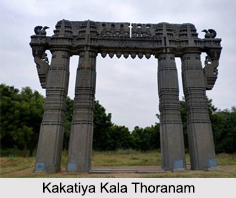 Kakatiya Kala Thoranam or Warangal Gate is a historical arch, which is located in Warangal District of Telangana. Warangal Fort has four ornamental gates, which lead to the destroyed Swayambhusiva Temple of Shiva; these gates are together called Kakatiya Kala Thoranam or Warangal Gates. The architecture of the gates are fine examples of the Kakatiya Dynasty and it has been officially granted as the emblem of Telangana. These gates quite resemble to that of Sanchi Stupa. Built around 12th century by the Kakatiya Dynasty, the monument has been included in the tentative list of UNESCO World Heritage Site.
Kakatiya Kala Thoranam or Warangal Gate is a historical arch, which is located in Warangal District of Telangana. Warangal Fort has four ornamental gates, which lead to the destroyed Swayambhusiva Temple of Shiva; these gates are together called Kakatiya Kala Thoranam or Warangal Gates. The architecture of the gates are fine examples of the Kakatiya Dynasty and it has been officially granted as the emblem of Telangana. These gates quite resemble to that of Sanchi Stupa. Built around 12th century by the Kakatiya Dynasty, the monument has been included in the tentative list of UNESCO World Heritage Site.
Architecture of Kakatiya Kala Thoranam
Each Warangal Gate has twin pillars with angled brackets over which there lies a huge lintel. The gates are 10 meters in height with intricate carvings of lotus buds, looped garlands, mythical animals, and birds with foliated tails. Northern and southern gates only are of 150 meters in height.
Kakatiya Kala Thoranam as the Emblem
As the structure of the arch is the emblem of the state, it is portrayed in English, Telugu and Urdu with a combination of green and gold colours written "Bangaru Telangana" on it, which means "Golden Telangana". The term "Government of India" is also inscribed on the logo in English, "Telangana Prabhutvam" in Telugu and "Telangana Sarkar" in Urdu. At the base of the logo there is an inscription in Sanskrit- "Satyameva Jayate", which means "truth shall triumph".
This article is a stub. You can enrich by adding more information to it. Send your Write Up to content@indianetzone.com.



















